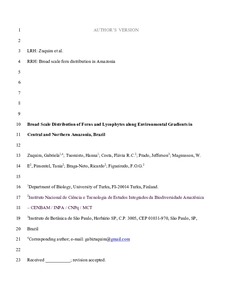Broad Scale Distribution of Ferns and Lycophytes along Environmental Gradients in Central and Northern Amazonia, Brazil
Braga-Neto R; Figueiredo FOG; Costa FRC; Magnusson WE; Zuquim G; Prado J; Tuomisto H; Pimentel T
Broad Scale Distribution of Ferns and Lycophytes along Environmental Gradients in Central and Northern Amazonia, Brazil
Braga-Neto R
Figueiredo FOG
Costa FRC
Magnusson WE
Zuquim G
Prado J
Tuomisto H
Pimentel T
WILEY-BLACKWELL
Julkaisun pysyvä osoite on:
https://urn.fi/URN:NBN:fi-fe2021042714581
https://urn.fi/URN:NBN:fi-fe2021042714581
Tiivistelmä
Establishing which factors determine species distributions is of major relevance for practical applications such as conservation planning. The Amazonian lowlands exhibit considerable internal heterogeneity that is not apparent in existing vegetation maps. We used ferns as a model group to study patterns in plant species distributions and community composition at regional and landscape scales. Fern species composition and environmental data were collected in 109 plots of 250 x 2 m distributed among four sites in Brazilian Amazonia. Interplot distances varied from 1 to ca 670 km. When floristically heterogeneous datasets were analyzed, the use of an extended Sorensen dissimilarity index rather than the traditional Sorensen index improved model fit and made interpretation of the results easier. Major factors associated with species composition varied among sites, difference in cation concentration was a strong predictor of floristic dissimilarity in those sites with pronounced heterogeneity in cation concentration. Difference in clay content was the most relevant variable in sites with uniform cation concentrations. In every case, environmental differences were invariably better than geographic distances in predicting species compositional differences. Our results are consistent with the ideas that: (1) the relative predictive capacity of the explanatory variables depend on the relative lengths of the observed gradients; and (2) environmental gradients can be hierarchically structured such that gradients occur inside gradients. Therefore, site-specific relationships among variables can mask the bigger picture and make it more difficult to unravel the factors structuring plant communities in Amazonia.
Kokoelmat
- Rinnakkaistallenteet [19207]
